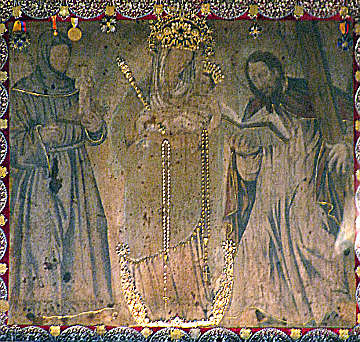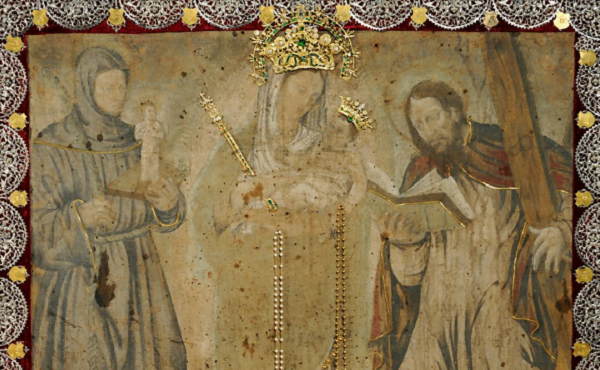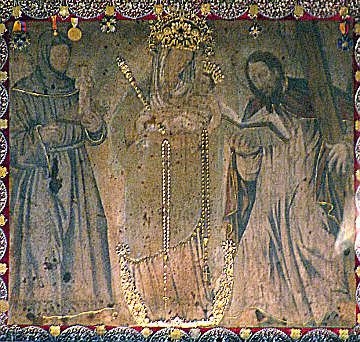OUR LADY OF CHIQUINQUIRA COLOMBIA

Feast: July 9 th
On a rustic cotton cloth of indigenous origin, a Spanish painter, called Alonso de Narváez painted with great artistry, an image of the Virgin of the Rosary.
In his palette he used tempera colors, with natural pigments taken from the mineral composition of the earth and the juice of herbs and flowers of the region. As the canvas was almost square (44 inches high by 49 inches wide), the artist balanced and completed the space by adding, on either side of the Virgin of the Rosary, the images of Saint Anthony of Padua and Saint Andrew the Apostle, the first being the patron saint of the encomendero who requested the image and the second of the friar who had it made.
In 1562 the painting was placed in a chapel roofed with straw in which the rain filtered and with it the humidity of the environment. This, together with the action of the air and the sun, left the painting in such a bad state that very soon it was impossible to recognize what had been painted on it.
In 1577 the deteriorated image was taken to the site of Chiquinquirá and abandoned in the room that once served as an oratory for the family.
Eight years later María Ramos, a pious Sevillian woman, arrived at this place and after cleaning and repairing the modest chapel, she placed in it the blurred canvas that one day carried the image of the Virgin of the Rosary.
On Friday, December 26, 1586, the image prodigiously recovered its original color and brightness in an instantaneous restoration, which closed the scratches and holes in the canvas, covering them with light and color. The Virgin of the Rosary in the center of the painting is approximately one meter tall; her gaze is turned to the left, diverting attention to the almost naked Child in her arms. She is a serene image whose delicate smile radiates great sweetness. The color of her face is pale, the same as that of the Child. Curiously, she carries in her right hand a little bird of bright plumage that a string holds to her thumb, and from her left hand she lets hang a small rosary. Our Mother rests her body on a crescent moon, in a position that suggests that she is on her way. She covers her head with a white headdress draped over her breast, and a light blue mantle envelops her pink dress. With the little finger of her left hand she holds a rosary that falls in the middle of her body and in her right hand she carries a queen's scepter.
The painting preserves the traces of the past deterioration and it is remarkable that the figures, which are vague or blurred up close, acquire their relief and depth when observed at a certain distance. Two crowns, a scepter, two rosaries and 27 gold shields have been superimposed on the canvas, giving a beautiful relief to the painting, whose frame, formed by silver semicircles, bears the insignia of the presidential decoration. For three hundred years the picture of the Virgin of the Rosary of Chiquinquira was presented to the faithful without any protection, counting by the thousands the objects that annually touched the flimsy cotton cloth.
The devotees used long sticks or canes to make various objects of devotion reach the blessed canvas. It is something really admirable that the cloth is preserved intact, in spite of the fact that so much manipulation, by force must have totally destroyed the fragile cotton fabric. Since 1897 a thick glass protects the painting from the inclemency of the weather and from rubbing with the devout pilgrims.
Pius VII declared her patron saint of Colombia in 1829, granting her her own liturgical feast. "La Chinita" as she is called by her people, was canonically crowned in 1919 and her sanctuary declared a Basilica in 1927.


